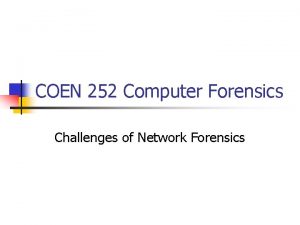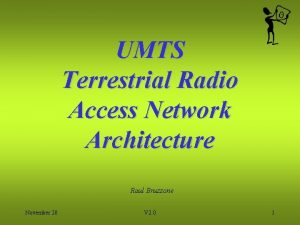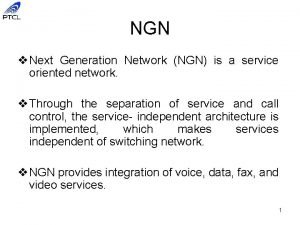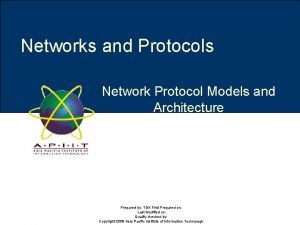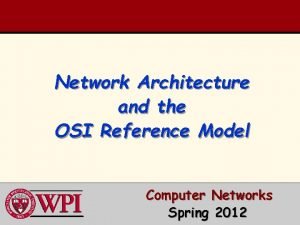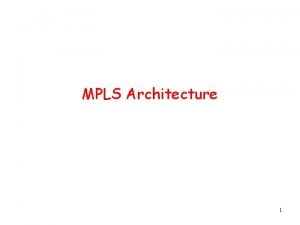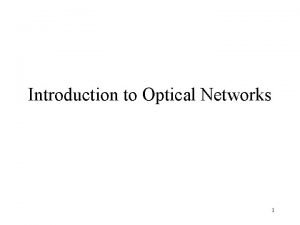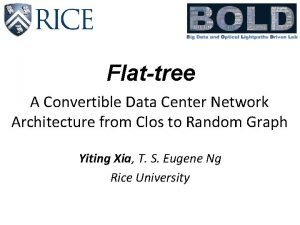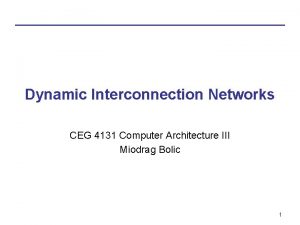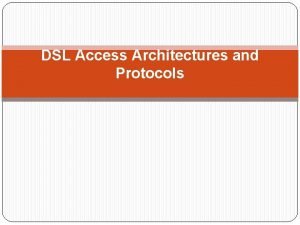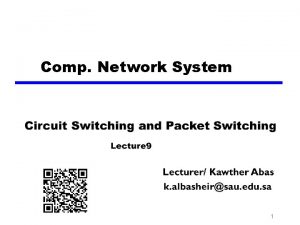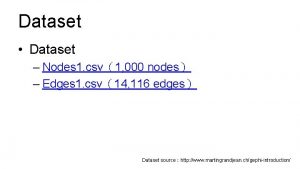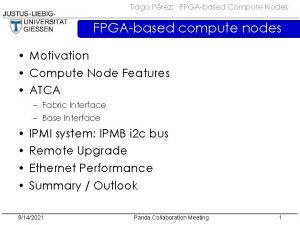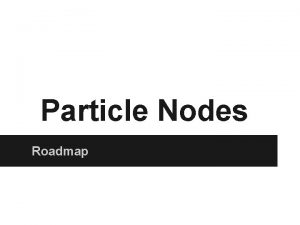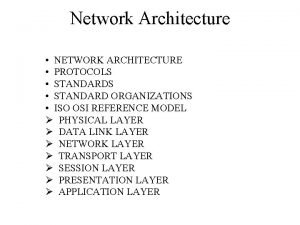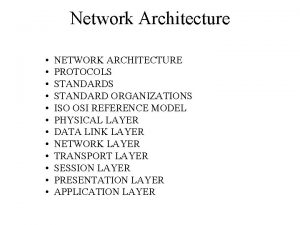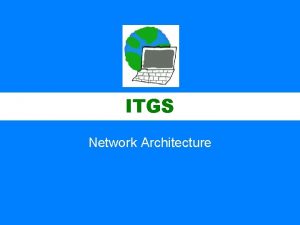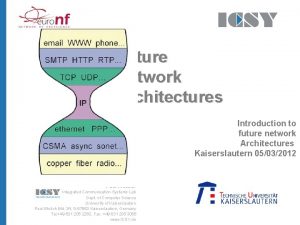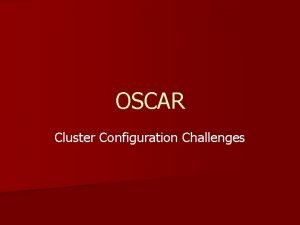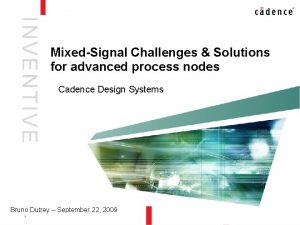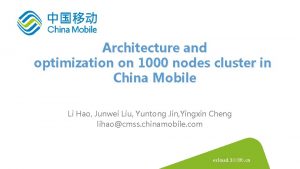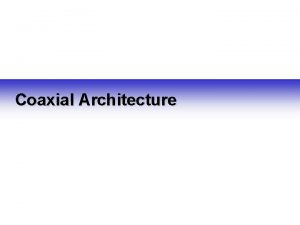Architecture Challenges in Future Nodes Network Nodes Prof

































- Slides: 33

Architecture Challenges in Future Nodes Network Nodes Prof. Gísli Hjálmtýsson Network Systems and Services Laboratory Department of Computer Science Reykjavík University, Reykjavík, Iceland http: //netlab. ru. is

Overview • • • Background and Motivation Reality Check & Implications for Routers A New Approach to Rapid Service Creation A New Architecture for Network Nodes Example Services Summary Gísli Hjálmtýsson – Háskólinn í Reykjavík – gisli@ru. is

Acknowledgements • Björn Brynjúlfsson, Heimir Sverrisson, Ólafur R. Helgason @ Reykjavik University • Bernhard Plattner, Kostas Katrinis @ ETH Gísli Hjálmtýsson – Háskólinn í Reykjavík – gisli@ru. is

Active Networking Motivation • Service deployment – rapid service creation – High margin for new services – competitive edge – Same drivers as for AIN in telephony • Standardization takes too long – IETF's complexity is growing exponentially – So is time to standardize – Multicast, mobile IP, IPv 6, etc. has taken forever • Technology trends – Rapid growth in bandwidth and # of transistors (cycles) – Counting instructions in data-path is passé Gísli Hjálmtýsson – Háskólinn í Reykjavík – gisli@ru. is

Proven that it can be done • No technical show-stoppers • Time scale of programmability – NOT AN ISSUE – Auto-deployment sufficient, timescales of minutes or hours • Time scale of activity – Principle of timescale – Per packet timescale hard, 100 times that easy • Model of programmability – Practical convergence • Interfaces – a number of viable alternatives – Packet processors minimize this interface • Program @ levels – services vs. extensible routers • Composability – Doable to some extent – Feature interaction problem remains. • Granularity – NOT a critical issue Gísli Hjálmtýsson – Háskólinn í Reykjavík – gisli@ru. is

Did Active and Programmable Fail? • No, but it does not warrant a separate discipline – AN ideas have gone mainstream • Sensor networks, adaptive middleware, autonomic networks, overlays • Significant impact on Router Architecture – All kinds of functions now appearing on routers – Modular routers, FORCES working group • Some of the same ideas appearing in overlays Gísli Hjálmtýsson – Háskólinn í Reykjavík – gisli@ru. is

Overview • • • Motivation Reality check & Implications for routers A new approach to rapid service creation A New Architecture for Network Nodes Example Services Summary Gísli Hjálmtýsson – Háskólinn í Reykjavík – gisli@ru. is

Reality check – Impact • No significant impact on router vendors – No significant router vendor offers an open programmable interface • No significant impact on the “Sigcomm” crowd – AN as a research agenda has died – AN has had some but limited direct impact on the agenda of other researchers • AN adds to the complexity of the Internet Gísli Hjálmtýsson – Háskólinn í Reykjavík – gisli@ru. is

Reality check – Complexity • Complexity is a real threat to the Internet • Configuration causes most Internet failures • … and dominates management cost – AN has NOT help with routing, addressing, or protocols • Need simplicity - must reduce the complexity – Self-configuration etc. is needed – Automation is not enough • The pressing problem that need to be solved is reduction in (distributed) complexity Gísli Hjálmtýsson – Háskólinn í Reykjavík – gisli@ru. is

Overlays have taken over • Service deployment is focused on overlays and P 2 P – The new network service has become DHT • Incremental deployment a critical issue – Application layer approaches inherently solve this • Increasing push for a cycle/pipe model – Nodes not offering cycles seen as dumb forwarders • Planet. Lab the mother of all overlays • Application level overlays offer a very simple programming interface – Inherent driver to maintain end-system model Gísli Hjálmtýsson – Háskólinn í Reykjavík – gisli@ru. is

Problems with Overlays • Introduce significant complexity – Cross-layer conflicts source of complexity – Prevent information exchange between layers. • Fail to exploit capabilities of the underlying facilities – Specific hardware support and network processors – Increasing agility of the lower layers (tunable lasers) – On-demand allocation of optical light-paths. • This is the architecture challenge in future networks – Finding the best (node) architecture for overlay based services Gísli Hjálmtýsson – Háskólinn í Reykjavík – gisli@ru. is

Overview • • • Motivation Reality Check & Implications for Routers A New Approach to Rapid Service Creation A New Architecture for Network Nodes Example Services Summary Gísli Hjálmtýsson – Háskólinn í Reykjavík – gisli@ru. is

Architecture goals • To self-configure and self-optimize, fully exploiting the hardware facilities at each node and across a network of nodes, without explicit instructions from network programmers. Gísli Hjálmtýsson – Háskólinn í Reykjavík – gisli@ru. is

Implications – Departure from AN • • Operate with very limited service information Move away from direct manipulation of facilities Instead adapt to observed use and traffic patterns Autonomic properties – observe and adapt – Self-configuring, self-optimizing, self-healing • Cross-node coordination of services – Largely ignored in AN research • Measurements become a first class functionality Gísli Hjálmtýsson – Háskólinn í Reykjavík – gisli@ru. is

Measurement: first class function • Measure and monitor service level topologies – Maintain consistent service quality – Monitor protocol behavior • Require observations inside the network – Accuracy, detail, timeliness and responsiveness – Network tomography only computes long term averages • Want generic mechanisms to provide – The right abstractions for service generic monitoring – Extensibility for service specific monitoring Gísli Hjálmtýsson – Háskólinn í Reykjavík – gisli@ru. is

Distributed Service Level Control • Control plane across multiple nodes – Common services need coordination between nodes • Much od the overlay/P 2 P work has nice ideas – Want to exploit them at control level – Still continue to get the benefits of network layer forwarding facilities • Maintaining and adapting the topology • Programmability is not a research issue – Easy to do – use with discretion where needed Gísli Hjálmtýsson – Háskólinn í Reykjavík – gisli@ru. is

Overview • • Motivation Reality Check & Implications for Routers A New Approach to Rapid Service Creation A New Architecture for Network Nodes – The old model – The new model • Example Services • Summary Gísli Hjálmtýsson – Háskólinn í Reykjavík – gisli@ru. is

The Pronto Router – A Node OS EE Node OS Environment manager Signaling Classifier Active Services User Other CPU Sched Packet Processors • Consistent with the DARPA Node OS framework • Service programming provided in EE • Router extensibility supported by packet processors Gísli Hjálmtýsson – Háskólinn í Reykjavík – gisli@ru. is Kernel

Service programming with Pronto • Dynamic introduction into EE (user level) – Program using C++, Perl, Java • Programmed by service providers • Typed flows, rather than typed datagrams – Still acts at connectivity level or at data level – May assign, and reassign policies at any time • Principle of timescales • Push functionality to the highest layer/plane viable for the timescale of a given task Gísli Hjálmtýsson – Háskólinn í Reykjavík – gisli@ru. is

Extensibility of the Pronto router • Packet processors – A new kernel abstraction – Provides programmability for hardware vendors • Simple abstract interface – Type specific service interface (SAPI) • Chains of packet processors make paths – Assigned to a filter in the classifier • Paths can cross into user space • … or cross CPU boundaries (NP) • Examples: EM – Forwarding, Tunnel entry/exit, IPSEC tunnels, NAT, TCP splicing, dropping, Qo. S, restoration, snooping Gísli Hjálmtýsson – Háskólinn í Reykjavík – gisli@ru. is

A model refinement – New Node OS Service Description Layer EE Node OS Distributed Control Plane Facilities Abstract facilities Incl. measurem. Resources HW, Network Pocessors, Optics • AN has not observed the boundaries • Focus has been more lower level Gísli Hjálmtýsson – Háskólinn í Reykjavík – gisli@ru. is User Kernel

Four layers of abstraction • Service Description layer – Goal oriented description of the service requirements – e. g. delay, jitter, loss rate; more fuzzy “interactive media” • Distributed Control Plane – Transforms the requirements to the available facilities – Coordinates across the nodes involved in the service delivery • Facilities layer – Abstract interface to the forwarding engine’s functions – Examples: packet classification, forwarding and tunneling • Resources layer – Special purpose resources for network functions on the node – E. g. tunable lasers, specialized hw, network processors Gísli Hjálmtýsson – Háskólinn í Reykjavík – gisli@ru. is

Overview • • • Background and Motivation Reality Check & Implications for Routers A New Approach to Rapid Service Creation A New Architecture for Network Nodes Example Services Summary Gísli Hjálmtýsson – Háskólinn í Reykjavík – gisli@ru. is

Examples • Basic IP Services – Service description: TCP/UDP – Distributed control: Routing, Network wide measurement collection and observation, load balancing, topology adaptation – Facilities: Classification, forwarding, local measurements, tunneling – Resources: Topology adaptation (e. g. optical path allocation), network processors, other special purpose hardware • Peer-to-peer CDN – Service description: Interactive streaming audio/video, cashing style CDN – Distributed control: DHT or other structure for locate/find, load balancing, overlay topology management, measurements – Facilities: Forwarding, tunneling for topology adaptation, local measurements – Resources: Low level topology adaptation Gísli Hjálmtýsson – Háskólinn í Reykjavík – gisli@ru. is

Examples II • Mobile support for streaming media – Service description: Whatever the base service is, e. g. interactive audio and/or video – Distributed control: user/entity registry used for locate/find, user tracking – Facilities: 1 -N classifier mappings, tunneling, local basic measurements (same as for multicast) – Resources: Same as for basic IP services • Enterprise level VPN – Service description: SLA – Distributed control: Basic IP, SLA conformance enforcement, dedicated topology management (e. g. for performance, or privacy/security), VPN specific routing, Authentication etc. – Facilities: Basic IP services, plus IPSEC – Resources: Same as basic IP services Gísli Hjálmtýsson – Háskólinn í Reykjavík – gisli@ru. is

Autonomic Multicast • Service description: – multipoint streaming - interactive or not, – delay/loss sensitivity • Distributed control: – Gtrace – measurement and monitoring, – SLIM multicast protocol daemon, – Autonomic service adaptation • Facilities: – 1 -N classifier mappings, tunneling, local measurements • Resources: – Same as for basic IP services Gísli Hjálmtýsson – Háskólinn í Reykjavík – gisli@ru. is

Autonomic multicast service • Have built network layer SSM (SLIM) – Self-configures over the unchanged Internet • Monitoring protocol to collect distribution attributes – Combines a multicast/gathercast protocol – Collect basic properties of distribution trees • Height, weight, losses, etc. • Each node in the distribution tree participates – Rapid tracking of tree properties • Every node in the tree knows subtree stats – Each node recursively can act like a root of a subtree Gísli Hjálmtýsson – Háskólinn í Reykjavík – gisli@ru. is

Gtrace monitoring • Local maintenance and collection – Collect information from local topology manager • Information distribution – Propogates queries and information from a collection point to nodes of the collection channel • Information gather – Gather information from nodes of the topology the root • Can dynamically change the ÷ and + functions Gísli Hjálmtýsson – Háskólinn í Reykjavík – gisli@ru. is

Effectiveness of the monitoring Gísli Hjálmtýsson – Háskólinn í Reykjavík – gisli@ru. is

Autonomic adaptability • Distribution tree recursively monitors performance • Provides consistent service quality throughout the distribution tree, by – Activate local retransmissions (reduce observed losses) – Increase priority of the data-stream (reduce latency) • Includes recovery/restoration (rapid rejoin) • Dynamic adaptation of the distribution tree – From shortest reverse path to minimum cost spanning • Example: TV station – Declares service level objectives (e. g. loss/delay) – Autonomically maintain consistent service quality Gísli Hjálmtýsson – Háskólinn í Reykjavík – gisli@ru. is

Overview • • • Background and Motivation Reality Check & Implications for Routers A New Approach to Rapid Service Creation A New Architecture for Network Nodes Example Services Summary Gísli Hjálmtýsson – Háskólinn í Reykjavík – gisli@ru. is

Summary • Direct manipulation of network facilities by service programmers increases complexity New paradigm – promote simplicity for services • Autonomically adapt to offered services – Adapt topology and functionality to match needs • Coarse grained service descriptions/objectives • Principle of timescales – match action and urgency • Local operations – service wide coordination Gísli Hjálmtýsson – Háskólinn í Reykjavík – gisli@ru. is

Summary • New architecture for network nodes • Four layers of abstraction – – Service Description layer – fuzzy service requirements Distributed Control Plane – coordinates across nodes Facilities layer – Abstract interface to facilities Resources layer – Allows cross layer manipulation • Goal to build the best node for overlay networks • See: http: //netlab. ru. is Gísli Hjálmtýsson – Háskólinn í Reykjavík – gisli@ru. is
 Future perfect by the time
Future perfect by the time Esercizi future continuous e future perfect
Esercizi future continuous e future perfect Ihrm trends and future challenges
Ihrm trends and future challenges Future trends and challenges of hrm
Future trends and challenges of hrm Challenges in network forensics
Challenges in network forensics Perfect future
Perfect future Rules of tense
Rules of tense See future continuous
See future continuous Future nurse future midwife
Future nurse future midwife Past continuous to future continuous
Past continuous to future continuous Present continuous for plans
Present continuous for plans Tenses in english
Tenses in english Future plans and finished future actions
Future plans and finished future actions Future continuous and future perfect
Future continuous and future perfect Nulti i prvi kondicional
Nulti i prvi kondicional Warren buffet network marketing
Warren buffet network marketing Software architecture definitions
Software architecture definitions Return architecture
Return architecture Modular product architectures
Modular product architectures Product architecture steps
Product architecture steps Bus architecture in computer organization
Bus architecture in computer organization Umts terrestrial radio access
Umts terrestrial radio access Osi model security architecture
Osi model security architecture Chordal ring
Chordal ring Ngn network diagram
Ngn network diagram Sun nfs
Sun nfs Network protocol architecture
Network protocol architecture Osi network architecture
Osi network architecture Ler network
Ler network Telecommunication network architecture
Telecommunication network architecture Gsm network structure
Gsm network structure Clos network data center
Clos network data center Dynamic interconnection network in computer architecture
Dynamic interconnection network in computer architecture Adsl network architecture
Adsl network architecture




